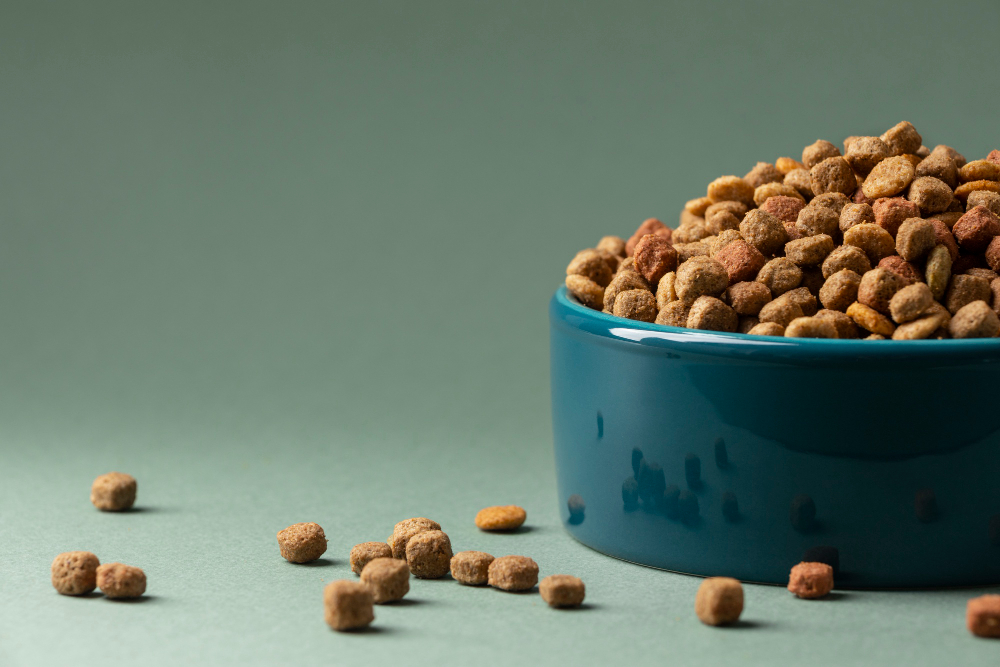Table of Contents
- Different processing methods can significantly impact the nutritional content of pet food.
- Extrusion and canning are the most common methods for dry and wet pet foods, respectively.
- Newer methods like freeze-drying aim to preserve more nutrients but may be more expensive.
- The best processing method depends on your pet's individual needs and your personal preferences.
- KibbleLab's tools can help you compare foods processed using different methods and find the best option for your pet.
01. Common Pet Food Processing Methods
- Extrusion: The most common method for dry kibble production. Ingredients are mixed, cooked under high pressure and temperature, then forced through a die to create kibble shapes [1].
- Baking: Another method for dry food, where ingredients are mixed into a dough, shaped, and baked in an oven.
- Canning: The primary method for wet pet food. Ingredients are mixed, cooked at high temperatures, and sealed in cans or pouches [2].
- Freeze-Drying: A newer method where food is frozen, then placed in a vacuum chamber to remove moisture, resulting in a lightweight, shelf-stable product [3].
- Raw Food Processing: Minimal processing where ingredients are ground and mixed in their raw state, then frozen.
02. How Processing Affects Pet Food Nutrition
- Heat processing can decrease the bioavailability of some nutrients but increase others. For example, while some heat-sensitive vitamins may be degraded, the digestibility of certain proteins can be improved through controlled heating processes.
- Some vitamins, particularly water-soluble ones, can be degraded by high heat [4]. B vitamins, especially thiamine (B1), are notably susceptible to heat damage [5]. This is why many pet food manufacturers add excess vitamins before processing or supplement them afterwards to ensure adequate levels in the final product.
- Protein quality can be affected by processing temperatures. High heat can cause Maillard reactions between proteins and carbohydrates, potentially reducing the bioavailability of certain amino acids. However, moderate heat treatment can also improve protein digestibility by denaturing proteins and inactivating anti-nutritional factors.
- Carbohydrates may become more digestible through some processing methods [6]. Processes like extrusion can gelatinize starches, breaking down their structure and making them easier for pets to digest. This can be particularly beneficial for pets that require more easily assimilated energy sources.
03. Choosing the Right Processing Method for Your Pet
- Consider your pet's age, health status, and specific nutritional needs.
- Think about convenience and storage capabilities in your home.
- Consult with your veterinarian about which processing methods might be best for your pet.
- Use KibbleLab's search to find and compare foods processed using different methods.
04. Looking to the Future: Emerging Trends in Pet Food Processing
The pet food industry is constantly evolving, with new processing technologies emerging. Some trends to watch include:
- High-Pressure Processing (HPP): A non-thermal preservation technique that can maintain nutritional quality while ensuring food safety.
- Microwave-Assisted Thermal Sterilization (MATS): A method that can sterilize pet food more quickly and with less nutrient loss than traditional nning.
- 3D Printed Pet Food: Customized nutrition through advanced manufacturing techniques.
KibbleLab is committed to staying ahead of these trends, ensuring our tools and information remain current and valuable for pet owners.
05. How KibbleLab Empowers Pet Owners
- Comprehensive Database: Access information on a wide variety of pet foods, including details on their ingredients and nutritional content.
- Smart Filtering: Easily find pet foods that meet your pet's specific dietary needs and preferences, including the ability to filter between dry and canned foods.
- Detailed Nutritional Information: View comprehensive details on the nutritional content of each food.
- Educational Resources: Access our knowledge base to learn more about pet nutrition and making informed decisions about your pet's diet.
Key Takeaways
- Different processing methods can significantly impact the nutritional content of pet food.
- Extrusion and canning are the most common methods for dry and wet pet foods, respectively.
- Newer methods like freeze-drying aim to preserve more nutrients but may be more expensive.
- The best processing method depends on your pet's individual needs and your personal preferences.
- KibbleLab's tools can help you compare foods processed using different methods and find the best option for your pet.

